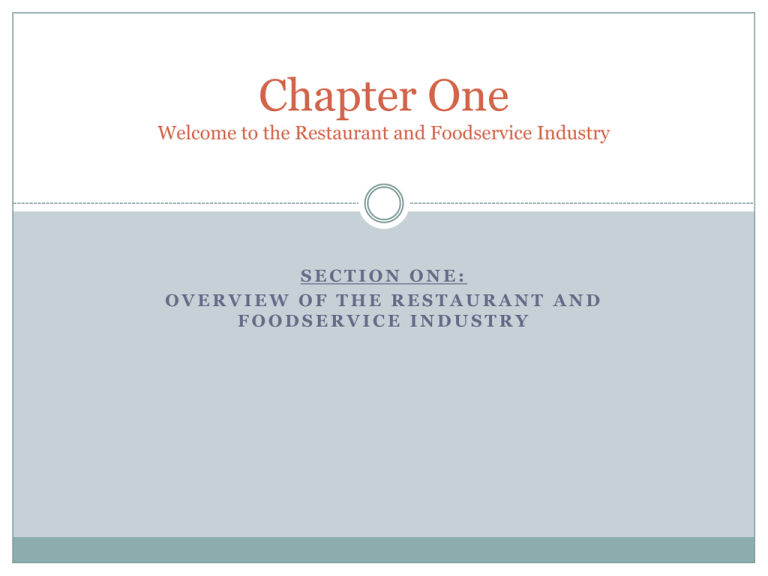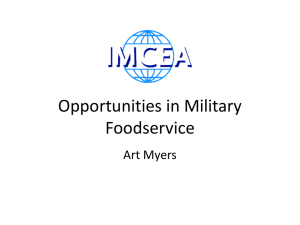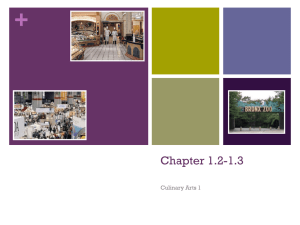Chapter One - School District of Clayton
advertisement

Chapter One Welcome to the Restaurant and Foodservice Industry SECTION ONE: OVERVIEW OF THE RESTAURANT AND FOODSERVICE INDUSTRY Overview of Foodservice and Restaurant Industry $550 BILLION DOLLARS ANNUALLY MORE THAN 945,000 FOODSERVICE AND RESTAURANT OPERATORS MORE THAN 13 MILLION PEOPLE EMPLOYED (9% OF THE JOB MARKET) The Restaurant and Food Service Industry Commercial Restaurant & Foodservice Segment Restaurants Catering & Banquets Noncommercial Foodservice Segment Eaten in the store or taken home Grocery stores, Convenience stores, specialty shops Vending Machines Stadiums: Menu chosen by host of the event Caterers may have their own facility or cater off-site Off-site catering involves preparing the food in one location and taking it to the event location Retail Quick Service (Fast Food) Fine-Dining Casual Theme Restaurants Buffets Cafeterias Food in stands to luxury suites Airline and Cruise Ships Airlines offer snacks to 7-course meals on transatlantic flights Cruise ships offer food 24/7 ranging from quick-service to elegant fine-dining The Restaurant and Food Service Industry Commercial Restaurant & Foodservice Segment Noncommercial Foodservice Segment Schools and Universities Provide on-campus food services to students and staff Military Bases and ships Provide food services to personnel Also offered at clubs; i.e. Officers Club Healthcare Hospitals, long-term range care offer foodservices Business and Industries Convenience to employers Benefit to employees in manufacturing or service industries Clubs and Member-based facilities Includes golf clubs, city, alumni, and athletic clubs Offered as a convenience to its members Brings in additional revenue Business done in two ways Contract Feeding Self-Operators Average sales over $1 million dollars The BIG Picture: The Hospitality Industry Travel and Tourism definition Travel and Tourism Transportation Hospitality The combination of all of the services that people need and will pay for when they are away from home Tourism defined Travel for recreational, leisure, or business purposes In 2005, tourism was the 1st, 2nd, and 3rd largest employer in 29 states 7.3 Million people to take care of 1.19 billion trips took within the United States In the 1800s, the invention of the railroad help The BIG Picture: The Hospitality Industry transport people faster to more places By the 1920s-people traveled by car 1950s- commercial airlines Travel and Tourism Transportation Hospitality Today's transportation Airplanes Trains Charter services Buses Cars Ships The BIG Picture: The Hospitality Industry Travel and Tourism Transportation Hospitality Hospitality is defined as The services that people use and receive when they are away from home Three Segments of Hospitality 1. Foodservice 1. Hotels 2. Restaurants 3. Retail Establishments 2. Lodging 1. Hotels 2. Motels 3. Resorts 3. Event Management 1. Stadiums 2. Expositions 3. Trade shows 400 B.C. through 300 B.C. The History of Hospitality and Foodservice Ancient Greece and Rome (400BC-300BC) The Middle Ages Renaissance - French Revolution Colonial North America Industrial Revolution The Gilded Age The 20th Century Ancient Greece Rarely dinned out Got together socially for banquets, at private clubs and other establishments Private clubs called “lesche (LES-kee)” Meals were considered a time to nourish the soul and body People ate while reclining on couches, listening to music, poetry and dancing Ancient Rome Settled around the Mediterranean Sea Meals served in the home Desired exotic foods and spices which increased trade Rome became wealthy and spent money lavishing their friends and those in the lower social standing 417 A.D.-1300 A.D. The History of Hospitality and Foodservice Ancient Greece and Rome The Middle Ages (417-1300) Renaissance - French Revolution Colonial North America Industrial Revolution The Gilded Age The 20th Century People moved from a nomadic group of hunting and gathering to that of a farming community This change was religion Feudal society where landowners lived in relative comfort Unlike the banquets of the Greeks and Romans, the medieval dinner had one purpose: to eat Travel was extremely dangerous The next 200 years, Europe was isolated from the rest of the world until 1095 A.D. Renaissance 1500 A.D -1700 A.D. The History of Hospitality and Foodservice Ancient Greece and Rome The Middle Ages Renaissance French Revolution (1500-1700; 17891799) French Revolution 1789 A.D.-1799 A.D. The use of exotic spices increased the spice trade between Venice and India Haute Cuisine was developed Coffee houses introduced women to public establishments and made it appropriate to eat in public Guilds in France were developed to increase the state’s control on the economy Colonial North America Industrial Revolution The Gilded Age The 20th Century Guilds could control their own specialties preventing others from making and selling the same items Two cooking guilds were the “roasters” and “caterers” 1765 the restorante was invented; origin of our modern word restaurant After the French Revolution, within 30 years, Paris had over 500 restaurants. 1600-1700s The History of Hospitality and Foodservice Ancient Greece and Rome The Middle Ages Renaissance - French Revolution Colonial North America (1600-1700) Industrial Revolution The Gilded Age The 20th Century First colonist were city dwellers and not trained to farm Boston and New York were centers of trade 1634, Cole’s tavern in Boston opened Offered food and lodging to travelers; hospitality industry is born However, once colonists settled down they rarely traveled more than 25 miles from their home 1750-1890s The History of Hospitality and Foodservice Ancient Greece and Rome The Middle Ages Renaissance - French Revolution Colonial North America (1600-1700) Industrial Revolution (1750-1890) The Gilded Age The 20th Century Cottage Merchants-families that lived and worked together to make goods Wool and linen for cloth Factories sprouted up near large cities Opened by orphan children; England outlawed such practice Merchants turned back to farming People migrated to cities to work at factories Lead to overcrowding and unsanitary conditions Horse and Buggy public transportation Business hubs Lodging Dining for workers to go from work to lunch and work to dinner quickly Railroad invention 1825 Inns, taverns, and foodservice facilities grew 1850-1890s The History of Hospitality and Foodservice Ancient Greece and Rome The Middle Ages Renaissance - French Revolution Colonial North America (1600-1700) Industrial Revolution The Gilded Age (1850-1890) The 20th Century Enlightenment-scientific revolution Concepts were measured in profit and production Low pay for workers, BIG pay for industrial leaders High society dined out in style Restaurants with 18 course meals were not uncommon Gold Rush of 1848 Those who struck rich wanted to experience the fine dining of high society More fine restaurants quickly opened; yet most couldn’t stay afloat Cafeterias opened to serve food quickly and cheap without servers In the 1800s, the chef uniform was redesigned to white to symbolize cleanliness and different sizes of hats to show the ranks of chefs and cooks 1900-1999 The History of Hospitality and Foodservice Ancient Greece and Rome More jobs meant more people eating out The Great Depression of the 1930s Hotels and restaurants started to close Yet quick-service (Fast Food) restaurants were able to open The Middle Ages Renaissance - French Revolution Colonial North America (1600-1700) Industrial Revolution The Gilded Age The 20th Century (1900-1999) White Castle opened its doors in 1921 World War II Lodging industry grew After the war, 1940-1950 the quick-service industry grew rapidly KFC and McDonalds opened its doors during World War II The invention of the car made it possible for people to travel more and eat out at different places 1958 brought in commercial airlines and foodservice in the sky











